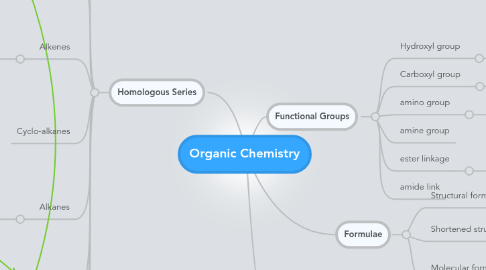
1. Homologous Series
1.1. Alcohols
1.1.1. good solvents
1.1.1.1. Polar
1.1.2. Classing
1.1.2.1. Primary
1.1.2.1.1. Oxidised by Potassium Dichromate to form aldehydes, then again to form carboxylic acids
1.1.2.1.2. 0/1 other carbon attached to carbon that is attached to functional group
1.1.2.2. Secondary
1.1.2.2.1. 2 carbons attached carbon that is attached to functional group
1.1.2.2.2. Oxidised to keytones which cannot undergo further oxidation
1.1.2.3. Tertiary
1.1.2.3.1. cannot be oxidised
1.1.2.3.2. 3 carbons attached...
1.2. Keytones
1.2.1. formed by oxidation of secondary alcohols
1.3. Alkenes
1.3.1. reactive
1.3.1.1. C=C has lower bond enthalpy than C-C
1.3.1.2. Addition reactions
1.3.1.2.1. Because Alkenes are unsaturated
1.3.1.3. Addition polymerisation
1.4. Cyclo-alkanes
1.5. Alkanes
1.5.1. Unreactive
1.5.1.1. Strong C-C and C-H bonds
1.5.1.2. low polarity
1.5.1.3. Only readily undergo combustion reactions with oxygen.
1.5.1.4. Substitution reactions with halogens under U.V. light
1.6. Aldehyde
1.6.1. Formed by oxidation of primary alcohols
1.7. carboxylic acid
1.7.1. can be formed by oxidation of aldehydes
1.8. Halogenoalkanes
1.8.1. Alkene + Halogen
1.8.2. Alkene + Hydrogen Halide
1.8.3. Alkane + Halogen (U.V. Light)
1.8.4. Can be categorised
1.8.5. Very useful intermediates in organic chemistry
2. Functional Groups
2.1. Hydroxyl group
2.1.1. R-OH
2.2. Carboxyl group
2.2.1. R-COOH
2.3. amino group
2.3.1. R-NH2
2.4. amine group
2.5. ester linkage
2.5.1. HCOO
2.6. amide link
3. Naming organic compounds
3.1. identify longest carbon chain
3.1.1. 1 carbon = meth-
3.1.2. 2 carbons = eth-
3.1.3. 3 carbons = prop- ect.
3.2. identify type of bonding in the chain or ring
3.3. Identify functional group
4. Formulae
4.1. Structural formula
4.1.1. full, showing all bonds and structure
4.2. Shortened structural formula
4.2.1. Skeletal formula showing grouped sets e.g. CH3CH2CH3
4.3. Molecular formula
4.3.1. Just showing ratio of elements in organic molecule
5. Benzene
5.1. Formula C6H6
5.2. Structure
5.2.1. Delocalised electrons above and below the ring
5.2.2. Carbon to carbon bonds are all the same length
5.2.3. Molecule is planar (flat)
5.3. Many consumer products contain benzene rings
5.3.1. Products that contain benzene are called aromatic compounds
5.3.2. One of the main uses of aromatic compounds is in petrol.

